
First to consider if changing out Chain Plates is whether to just replace the originals with the exact same design, or to rethink the pros and cons to see if there might be something better.
A CSY modification like this has been done by a number of owners; externally mounted, not internal, 1/2" plate not 3/8", wide 4" tang not 2", 316 polished/highly corrosive resistant stainless steel/more bolts(8 not 6)/countersunk to eliminate moisture trapping or line snagging, wider footprint gripping the hull, moreso than original 5 bolt base/not less.
Some have replaced the original "Internal" plates and tried to keep them bedded properly. One, has tried to use a superior stainless steel (duplex) and make a one piece replacement rather than a weldment, yet stay with internal mounting. The replacement of chain plates brings up the question of pro's and con's of either Internal or External plates. Internal plates can be removed and a shop can make up 'exact' replacements(each plate tho, will have different angles) plus all the original problems of potential leaks and crevice corrosion/inaccessible inspection through deck/cap rail material. External plates are one piece cutouts and therefore identical to each other; only afterwards are the plates tangs bent inward at the appropriate fore or aft angle needed to align with the stay or shroud. Internal plates have been a weldment but an exit slot might need to be modified if New Plates are cut from one piece of stainless steel or thicker. External need to be better looking, so polishing manually or electro-polishing is the norm
 , and both measures highly reduces degradation or even discoloration later.
, and both measures highly reduces degradation or even discoloration later.10" circular plate with "Double Tang", mounted above original rub rail/shown on pilothouse ketch. (a tang wide enough for 2 attachment holes, allow adding a shackle for an extra attachment point (when needed) + extra beef in the tang area ) click on photo for better view
Do not forget, that a 33' CSY and a 44' have different size plates, so the amount of S.S. might be double on the bigger boat. Also if you go From a thinner plate to a thicker plate....again you are using more Stainless Steel and it's sold by the pound. IF you are going to mount your plate where you can see it...you probably want it to shine. That will cost some in time or dollars for the labor required. Manual polishing is beautiful and worthy of time and effort, but so is Electro Polishing, as it also protects the surface from rusting. Manual polishing and electro polishing combined, is even better! A no brainer!
VERTICAL STRAPS used on this CSY 37 looks traditional but round would look great too and have more plate and bolts. Skinny straps have a history of breaking so why go there?
It should be noted that Peter Stolken, ex floor manager of the CSY plant, later on-added external chain plates-to his own prototype CSY pilothouse. His vertical straps are common for external chain plates on wooden boats and
 the look agrees with traditional aesthetics drawn by Peter Schmitt for the CSY.
the look agrees with traditional aesthetics drawn by Peter Schmitt for the CSY.On wooden boats, vertical straps are tied into the vessels planks. Fiberglass boats can use the older aesthetic or build plates tied into the hull horizontally (as CSY plates do to use the support structure of the hull's glasswork.)
Peter's "Independence"(above), a custom/one off pilothouse has retrofitted external vertical chain plates. Photo by David Kummerel. click to enlarge any photo

A 4" tang on another design offers strength plus original 6 bolts. Machine work by JTR/Gulfport, Fl.
After learning of possible chain plate problems in the late 90's, I started to research how other boats were handling the design issue. Steve Dashew's circular design for his Deerfoot Yacht chain plates looked good to me. (It's on page 582 of his Cruising Encyclopedia.) CSY had used a 1/4" triangular base with 5 bolts and one above, welded to a vertical 3/8" piece of flat bar which became the tang above deck. I took Dashew's circle idea, to make a 10"diameter with 4" tang, cut out of one piece of 1/2" thick, 316L stainless steel, mounted externally. One piece/no welds or it's possible crevice corrosion/ thicker material/ highly polished for less corrosion/more bolts-8 vs.6/ countersunk for less chance of crevice corrosion of the attachment bolts, yet inspectable and accessible. The 10"diameter will clear all 44' CSY's. In every aspect, more rather than less than original.

Above:
External 10" plate mounted before new external high rub rail was added. The teak cap rail is removed here BUT, that is not a part of this chain plate job!
A small amount of the original teak cap rail can and should get cut away, to allow the external plate tang to lie flush against the fiberglass of the hull.
S.V.BEAUJOLAIS replaced chain plates in Panama. Rick Heim of Gulfport Machine, St. Pete, Fl. made and shipped them. Work was done dockside, with Roger and a local worker taking on the task. Looks good huh? Roger admits a little extra time later on will be needed to make things bristol again, but I think they did a fine job.
I designed these circular plates for 'my' boat, but offer photos and text for others to investigate. As you can see, the plate fits 'properly'.
-CSY original chain plates were internally mounted and their tangs penetrated the cap rail. This left the tang encapsulated through fiberglass and teak for about 2" and could not be checked for crevice corrosion down in that area.
Drawing of plate (above).. note upper 2 holes were slightly lowered so that nuts and washers could be easily installed-inside the hull- and below interior of cap rail. Center bolt lowered only for aethetics of design/it Looks better than centered!
External plates, instead of the internal ones, can be inspected visually and if caulking is necessary; it is easy to accomplish. -CSY interior plate used 6 bolts-the circular external 10"design uses 8 (and countersunk bolts that are easy to bed/seal; note: I do not recommend External Hex Head bolts which catch a lazy sheet an
 d are more likely to suffer from crevice corrosion under their heads as they are near impossible to keep caulked/sealed perfectly.
d are more likely to suffer from crevice corrosion under their heads as they are near impossible to keep caulked/sealed perfectly.NOTE: The Single 2" Tang design was scrapped by me.The Advantage of wide double hole tang was too overpowering to dismiss, so all plates were made with 4" tang.
(Click on any photo to enlarge it).
Use of flat Socket Head bolts (special order)sit flush with the outer plate and offer a strong grip for tool installing or removing that Slot or Phillip heads do not. CSY, the flat head end of the chain plate bolt was embedded in the rub rail and not accessible. -Going to "external plates", gives you the option of easily changing out bolts if you are concerned as they are not embedded but installing 316 grade bolts in the first place solves future problems. -CSY plates were welded, this design is not.
/
 S.V. Soggypaws/WT 44, with 10" plates and wide 4" tangs, installed in 2005. Dave chose to remove the teak cap rail, adding instead an aluminum slotted toe rail forward.
S.V. Soggypaws/WT 44, with 10" plates and wide 4" tangs, installed in 2005. Dave chose to remove the teak cap rail, adding instead an aluminum slotted toe rail forward.Plate project took Dave and Stacey / husband wife team, about a week.
Mounting externally, helps reduce the possibility of oxygen deprivation and therefore should fair better in the elements. Also, they are easy to inspect.
A slightly different twist on the circular design was used by Pete a few years ago, out on the west coast on his boat Imagine. check out this link to his efforts, including his comments on cutting stainless steel using water jet technology and it's very reasonable cost.
www.imaginecruising.com/web/the_boat/repairs_and_reinforcements.htm
As said before, if you were buying a late 70's car of any 'make', you would do a number of things to make sure it is up to specs for a good safe ride. No mater what boat you chose, do the same. Be safe, stay well and keep smiling, it does not add anything significant to the cost of the vessel and really helps to bring back the strength and safety factor.




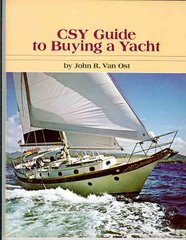
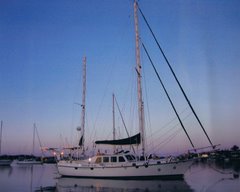
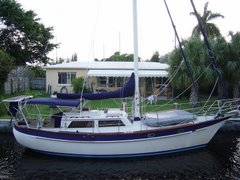
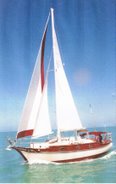
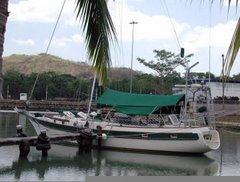
No comments:
Post a Comment